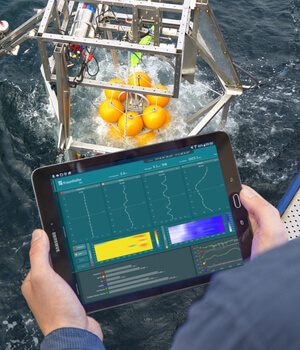Lab for underwater research in the Baltic sea
The Budget Committee of the Bundestag, Germany’s federal parliament, has cleared the path for millions of euros in science funding. In the state of Mecklenburg-West Pomerania, the Fraunhofer Institute for Computer Graphics Research IGD is slated to run a new underwater laboratory in the Baltic Sea for researching and developing underwater technology for an array of undersea scenarios. This “Digital Ocean Lab”, headquartered in Rostock, is a key component of and the gateway to the world’s first “Ocean Technology Center”--a campus of innovation for underwater technology to promote close collaboration between businesses and research facilities, and develop new products and services. This will make Rostock one of the leading sites for underwater technology research of international significance in the coming years. Mecklenburg-West Pomerania has already firmly pledged its financial support and with the approval of federal funding, a critical building block for realizing this infrastructure project has been added.
Significance of an undersea test site
The difficult conditions in seawater make intensive, practical tests essential for reliable solutions. However, thus far there have been hardly any possibilities to test complex underwater systems and how they interact in real scenarios. The new offshore infrastructure of the “Digital Ocean Lab”, linked to the artificial reef off the coast of Nienhagen, will make it possible to develop and test underwater technology under real ocean conditions. The plan includes various underwater testing areas designed to cover the entire spectrum of underwater applications. Testing areas for detecting old munitions, areas with cable looms and pipelines, reproduced offshore installations and simulated obstacles will be divided into separate zones. Fraunhofer IGD’s research will focus on optimized underwater image processing along with developing both remote-controlled and autonomous submersibles, which are used wherever humans would only have access under very challenging conditions (offshore installations) or would even have to accept personal risk (old munitions).
 Rostock leading underwater technology research worldwide
Rostock leading underwater technology research worldwide
Underwater technology and its research and development constitute an interdisciplinary high-tech segment with large growth potential (image left*). As the world’s leading institute for applied visual computing research, Fraunhofer IGD has years of expertise in image-based underwater research at its second location in Rostock as well as valuable connections in the maritime and scientific community in Northern Germany. In close collaboration with other Fraunhofer institutes and scientific research facilities in Mecklenburg-West Pomerania, the “Digital Ocean Lab” will produce an interdisciplinary project team with unique know-how. “With this lab, we will create the ideal conditions for the research topics of today and tomorrow, thereby raising our Hanseatic city’s maritime profile,” said Prof. Uwe Freiherr von Lukas, managing director of the Fraunhofer IGD in Rostock.
Underwater research and its challenges
The sea and its depths are a harsh environment that pose special challenges to humans and technology. Underwater systems of any kind need to operate with considerable autonomy, freed from WiFi and GPS. New communication and sensor solutions are in demand. Underwater conditions themselves--high water pressures, saltwater, biofouling, and powerful and unpredictable ocean currents--require specific and durable solutions as well as innovative materials. The detection of old munitions is an important field of application for underwater technology and is a major challenge given the poor visibility under water. At its Rostock site, Fraunhofer IGD is working with regional partners to develop sophisticated algorithms to improve underwater imaging quality so objects such as undetonated munitions can be detected, segmented and classified. The next step in the technology is already being taken: a smart camera in which AI-based, real-time image enhancement and object detection are implemented directly in miniaturized digital technology.
* The new offshore infrastructure of the “Digital Ocean Lab”, linked to the artificial reef off the coast of Nienhagen, will make it possible to develop and test underwater technology under real ocean conditions (Image: © Fraunhofer IGD)
- Source:
- Fraunhofer Institute for Computer Graphics Research IGD
- Author:
- Press Office
- Link:
- www.igd.fraunhofer.de/...
- Keywords:
- Rostock, Digital Lab, ocean, research, offshore, test lab, lab, raunhofer Institute for Computer Graphics Research IGD, Baltic Sea






















